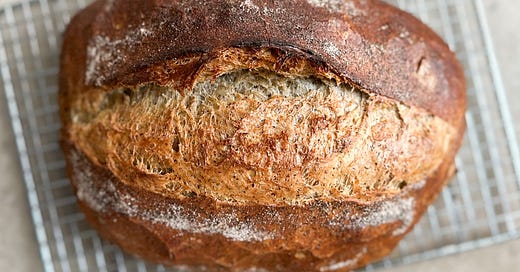The Cutest Grey Loaf
An easy no-knead crusty bread recipe to honor the two cutest loaves around.
A few too many weeks have passed since my last newsletter. It’s been tough the past few weeks for me, as for many of you. But with all of the horrible, hate-filled, hair-brained things in the word, I found some joy: two sweet grey cats. Jason and I welcomed these furry little housemates last week, and we’ve fallen in love.
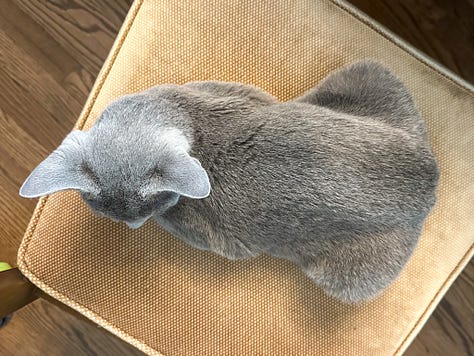
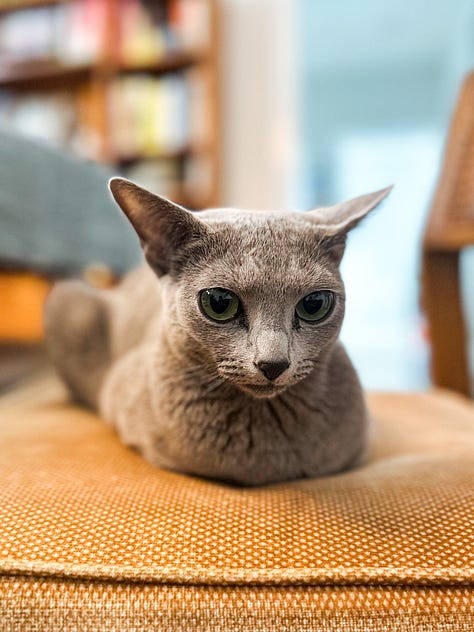
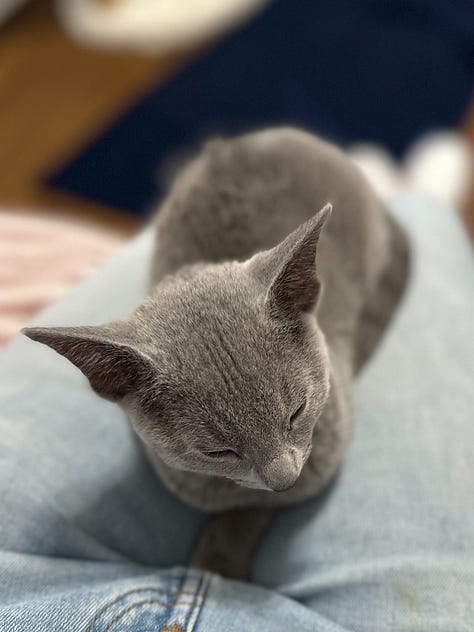
I grew up with cats, but very unexpectedly so. When my paternal grandfather was old, we regularly trekked from Indiana to rural central Ohio to visit him at my aunt’s house. They had some land and some animals. I wouldn’t call it a farm, and I wouldn’t call it well-run. I remember some horses wandering around, mean dogs prowling outside, and my sisters and I shooing chickens out from under the car. On one of these trips, we hung out with grandpa inside the house, when a little, somewhat scraggly, orange and white kitten emerged from a clothes hamper. One of the “farm cats” had a litter, and somehow, this little cutie greeted us in the living room. Though a bit wiry, she was adorable, playful, and affectionate. I was probably in fifth or sixth grade then, and I joked with my folks about adopting the kitten. My aunt didn’t mind. After a few hours of her playing with makeshift toys and curling up on our laps, my sisters and I begged our parents to take the wee cat home with us.
My father and I are allergic to cats. After a few hours of playing with the kitten, my eyes were red and itchy, my nose ran, and I had a few red welts on my hands. But histamines were no match for that little furball; I loved her already. We had never, ever thought about getting cats. We weren’t cat people. If anything, we were dog people because we had a Shih Tzu named Lee Lee when I was very little, who was memorialized in professional photos around our house. We never thought of or talked about having cats. (I would later learn that my father cannot resist a baby animal.)
But of course, this kitten looked and acted adorable, so, after many hours of pleading to keep her, our parents acquiesced. We took an aluminum pie plate full of kitty litter, a cardboard box lined with an old towel, and a container full of cat food and drove three hours home. That’s how we welcomed our cat Zoe home.
After we rid her of fleas, ringworm, and ear mites, she was a fluffy, sweet, snuggly, rambunctious addition to our household. After a couple of weeks, my allergies completely vanished. A few years later, a neighbor came to our door with a kitten in a cardboard box, and we welcomed sprightly grey short-haired Ophelia (Ophie). My parents didn’t even hesitate this time. We were officially cat people.
These days, my folks have a fluffy, snuggly, ornery calico named Calliope, who has my father at his beck and call. Callie begs Dad to open the door to the screened-in porch, turn on the shower briefly so that she can drink some water, or—most of all—demands he sit down so that she can climb up onto his tummy so they can snooze. Every time we visit my folks or any of our friends who tend to cats, I fawn over them and yearned for one in my house.
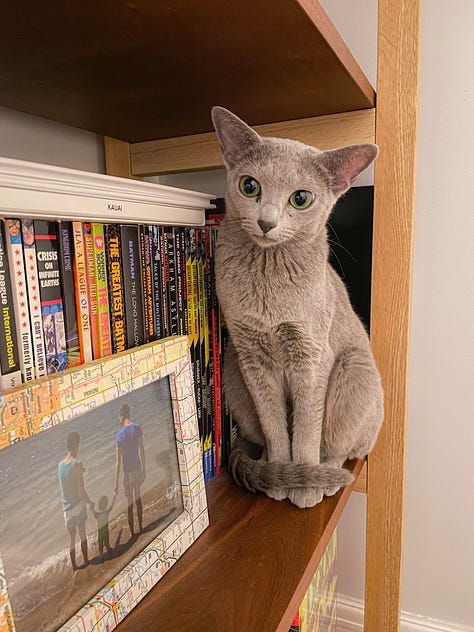
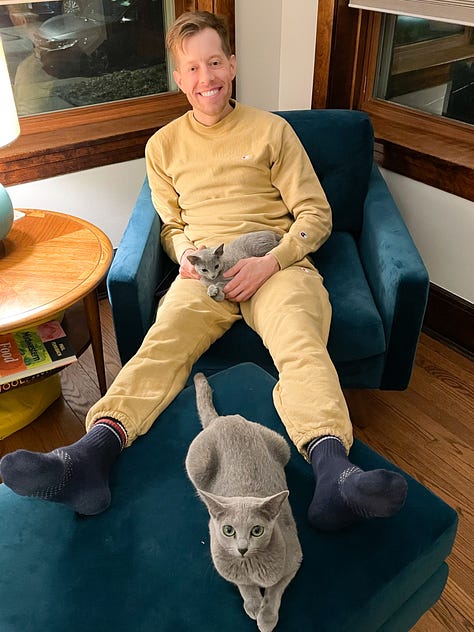
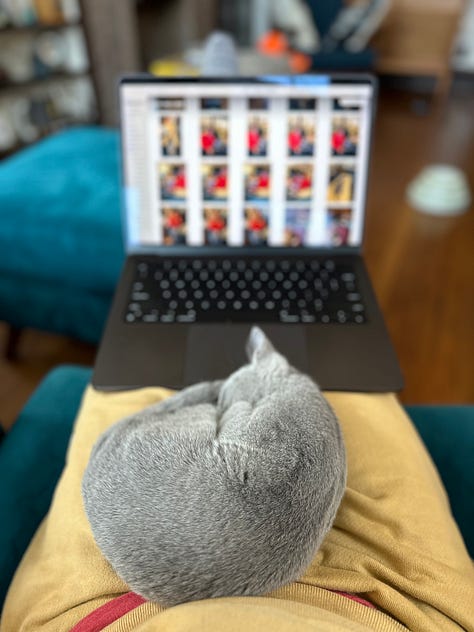
It took me almost two decades to convince my husband to actually like cats, then another couple of years to persuade him to adopt a cat. Now he’s a proud, cuddly, caring helicopter guardian to Danube (Dani) and her daughter Rio Grande (Rio), our two little grey Runabouts. He is thoroughly smitten, as am I. This week’s recipe is dedicated to them. I wrote most of this post with Rio on my lap and Dani at my feet. They warm our home like two loaves of freshly-baked bread.
The Cutest Grey Loaf
Also known as, no-knead 10% buckwheat hearth bread.
Y’all know that I’m downright evangelical about buckwheat. This gluten-free, flavorful pseudocereal can often replace all-purpose flour in cakes and cookies. Did you know it also plays well with regular, old wheat flour? A mere ten percent buckwheat flour in a loaf of crusty bread adds that earthy, grassy tone and a mysterious speckled grey crumb. I have no clue about the science here, but something about the buckwheat flour gives yeasted and sourdough loaves tremendous flavor despite such a piddly amount. It also causes them to brown to a sexy, rich chestnut color. Use dark or whole-ground buckwheat flour—I prefer it from Janie’s Mill.
Makes one 700 g loaf.
Takes at least 12 hours, but only about 10 minutes of active time and 45-50 minutes of baking.
360 g (3 cups) bread flour
40 g (1/3 cup) whole buckwheat flour
8 g (1 3/4 teaspoons) fine sea salt
1/4 teaspoon instant yeast
300-320 g (1 1/4 cups) cool water
10 g sourdough starter (optional, but adds flavor)
In a large mixing bowl, whisk together the bread flour, buckwheat flour, salt, and yeast. Add the water and sourdough starter (if using) and stir with a dough whisk or a wooden spoon until you don’t see any dry flour and you have a wet, shaggy dough. Cover and rest for 30 minutes. Do three or four sets of stretches and folds, as described here. Let the dough ferment for another 6-10 hours. It should have risen tremendously and resemble a bubbly cauldron.
Lightly flour your work surface with either buckwheat or bread flour. Scrape the dough out of the bowl and onto the floured surface. Gently lift and fold the edges toward the center, working your way around the dough. Flip the dough over so the seam faces down. Using your bench scraper or hands, drag the dough toward you on the counter—this creates tension. Let the dough rest for 20-30 minutes. Cover with a large bowl if needed, but it’s not necessary.
Flip the dough over so the seam faces up again. Shape the dough into a round boule, as shown here, or oblong bâtard, as shown here. A boule works best if you bake it in a round dutch oven or combo cooker. Place into a flour-dusted banneton basket or into a bowl lined with a tea towel generously dusted with flour (for a boule). Let the dough proof for 45-90 minutes, until well risen, jiggly, and when poked with your finger, it only springs about halfway back. You will need to preheat your pan and oven 45 minutes before the loaf is proved, so it’s a bit of a guessing game.
45 minutes before the loaf is ready, place an oven rack in a lower-middle position. Put a cast-iron combo cooker, Dutch oven, or the perfect bread pan inside. Set the oven to 450F and set a timer for 45 minutes. After 45 minutes, take your baking vessel out of the oven. Invert the dough onto a piece of parchment paper. Lift the parchment and the loaf and place them into your vessel. Spritz the loaf with some water, then replace the lid and return to the oven. Turn the heat down to 425F and bake for 25 minutes. Remove the lid and bake for another 18-25 minutes. The loaf should be broodingly dark chestnut brown. (Whenever I add buckwheat flour to a bread dough, the loaf darkens more quickly and deeply.) Take the loaf out of the oven and immediately transfer to a wire rack to cool completely.
Enjoy. The loaf is best the day it’s made and the day after, but it makes fabulous toast the following days.
Happy Baking,
Martin


